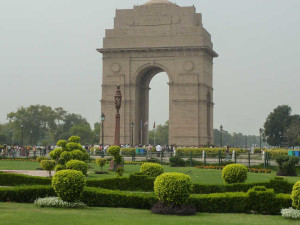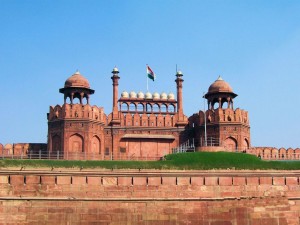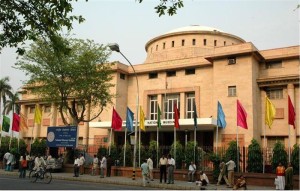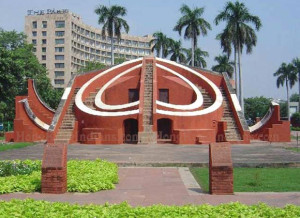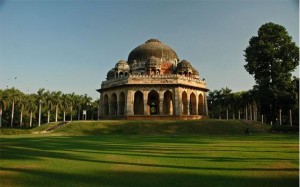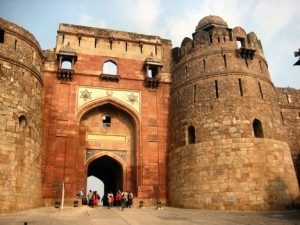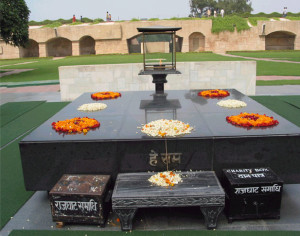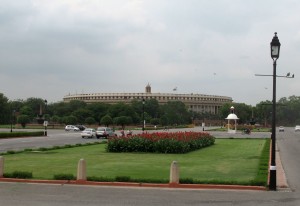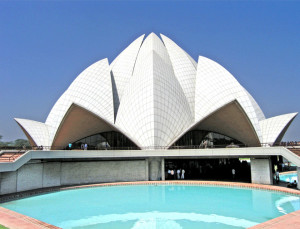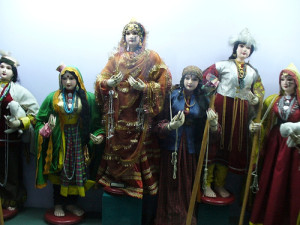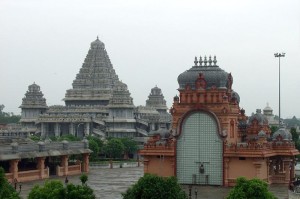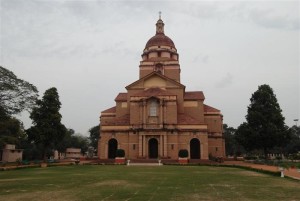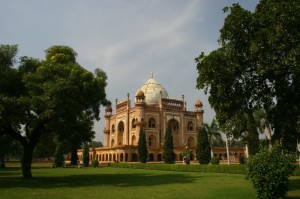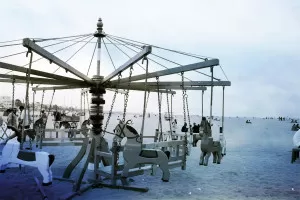There are stunning and breath-taking places to visit in New Delhi. New Delhi, the capital of India, is quite famous for its majestic vistas and mansions built during the British rule in India. It has a striking contrast to Old Delhi, which is full of Mughal monuments and buildings belonging to the 16th and 17th century and crowded marketplaces. The picturesque colonial buildings and the remains and ruins of the rulers of the country throw light on the history of our nation. Its location has always been an advantage for easy administration, right from the erstwhile rulers till date. Hence, it has seen continuous development over the years. Today, New Delhi is an urban city and is a mirror to the contemporary and modern nation that it is developing. Out of the innumerable places, a few very important ones can be listed as below.
Rashtrapati Bhavan:
The Rashtrapati Bhavan, which currently serves as the official residence of the President of India, was initially built to serve as the British Viceroy’s palace. It was designed by Sir Edward Lutyens and is located at the heart of Raisina Hills. It is spread over an area of 5 acres. It is built of beige and colored sandstone, with over 300 rooms. There is a main hall beneath a huge dome, where all the essential tasks and ceremonies are carried out. The Mughal Gardens in the Rashtrapati Bhavan are equally famous for the beautiful fountains and well-maintained landscape.
India Gate:
India Gate is a structure that many a times has been used to symbolize New Delhi. It is a gigantic arch, made up of red sandstone. It was built in the honor of the soldiers who had lost their lives in the First World War. Furthermore, an eternal flame has been kept burning there to commemorate the loss of soldiers who died in the Indo-Pak war in 1971. A canopy had also been built facing the India Gate with a statue of King George V but it has been moved to the Coronation Park later.
Red Fort:
Red Fort is one of the most important and touristic places to visit in Delhi. Endearingly known as Lal Qila, it is situated adjacent to the Chandni Chowk. It is a special place for each and every Indian since this was the spot from where the First Prime Minister, Mr. Jawaharlal Nehru gave the first speech after Independence. Made up of red sandstone, this building has many a stories from the past to narrate.
National Museum:
A must visit place in New Delhi, National Museum stores a striking collection of over 200000 pieces of art and artifacts. It boasts of a collection of objects from the Indus Valley and Harappan civilization. It also possesses some of the choicest Central Asian treasures from the Silk Route. Its Serindian Collection includes the artifacts and treasures that archaeologists discovered on their expeditions in the Taklamakan Desert. From miniature paintings to numismatic gallery, from sculptures to rare cloth work, National Museum has it all to make one feel proud of the country.
Jantar Mantar:
Built by Sawai Jai Singh II of Jaipur, this excellent structure was meant to be an observatory. A striking example of the interest in science and astronomy, it was built in 1724 and used by Jai Singh to study the positions and the alignments of the stars and other planetary bodies. The instruments or ‘yantras’ were built in such a way that they were resistant to any vibration or movement and ensured accuracy of readings. The instruments were used to measure the sun’s shadow and altitude and for the verification of the time of the spring equinox.
Lodi Gardens:
Lodi Gardens is one of the most beautiful and scenic parks one can come around in India. It is a favorite haunt of joggers and fitness enthusiasts. Its stunning flowerbeds and well-maintained lawns provide a very pleasant sight. There is a tomb of Mohammad Shah, the 3rd emperor of the Sayyid dynasty, in the garden and is believed to be the oldest among those kept there. The tomb of Sikander Lodi is located on the west part of the gardens.
Purana Qila:
Literally translated as ‘Old Fort’, the Purana Qila rests on a site which is believed to be as old as 1000 BC, if archaeological excavations are to be believed. The Mughal emperor Humayun and the Afghan chieftain Sher Shah Suri, both built new structures in the building at their respective ruling periods. Most of them are destroyed and only a few parts are remaining that include the Qila-i-Kuhna Mosque, Humayun’s Library (also named as Sher Mandal) and the Bara Darwaza.
Humayun’s Tomb:
Humayun’s Tomb is another stunning example of the artistic genius of those times. Many later Mughal structures and buildings drew inspiration from its Persian architecture and designs. It was built by the senior widow of Humayun, Haji Begum. The white marble dome and the trellis or the signature jali work can be seen here. The graves of Humayun, his wives and his son rest here.
Jama Masjid:
It is one of the most historical places to visit in Delhi as it is one of the oldest mosques. Built by Shah Jahan in 1658, it is an outstanding structure consisting of two minarets, four angle towers and three gateways. A spectacular view of the city can be enjoyed from the top of the minarets.
Chandni Chowk :
Although the place is too crowded and congested, this is the most happening marketplace in Delhi. There is nothing in the world that you cannot find here. Located opposite the Red Fort, Chandni Chowk is the place to be if you want to go on a shopping spree. Digamber Jain Temple is one of the main attractions of the area. There is also a Bird Hospital near Chandni Chowk. From Sunheri Masjid, Nadir Shah ordered his troops to plunder and massacre Delhi. Buy some fineries from Chandni Chowk because you will not get the things better anywhere else.
Qutub Minar:
Qutub Minar is one of the most visited places of India. In fact in the year 2006 it was India’s most visited place when it attracted 1.4 million visitors more than Taj Mahal (2.5 million). Started by first Muslim ruler in India Qutb-ud-din Aibak, it was developed by Iltutmish and finished by Firuz Shah Tughluq. It a beautiful piece of Indo-Islamic architecture that is primarily built out of red sandstone. It holds the world record for being the world’s tallest brick minaret. There are beautiful decorations and quotes form the Quran on the minaret surface. There are some other beautiful monuments in the Qutub complex including the Iron Pillar that is supposed to grant your wish if you can encircle you hands around it with your back towards the pillar. (access prohibited now for corrosion fears)
The Raj Ghat:
This is one place where people come to pay respect to all those freedom fighters and leaders who were cremated here. The Raj Ghat is one of the most popular tourist destinations in Delhi. To the north of Raj Ghat, tourist visit the cremation ground of the First Prime Minister of India, Pundit Jawaharlal Nehru. The place is called Shanti Van. You can also visit the cremation ground of former Prime Ministers of India.
Parliament House:
Parliament House, again designed by Lutyens, is a circular structure close to the Rashtrapati Bhawan that you must visit to appreciate its architectural genius. You can also move to the Supreme Court Buildings, racecourse and crisp avenues to appreciate the open spaces as conceived by the English architect Edwin Lutyens. Food from the circuit houses comes cheap and delectable as well.
Lotus Temple :
Baha’i Temple in Delhi is often compared to the Sydney Opera House. Located 12km southeast of Connaught Place, has emerged as a top attraction for the tourists. Popularly known as the Lotus Temple, Baha’i Temple is a major feature of Delhi and is well known for its appearance. There is no doubt that in years to come the temple will prove to be a mecca for the visitors. Baha’ism is considered to be a syncretism of the nine great religions of the world and traces its genesis to its prophet Baha’u’llah, born in Persia in the twentieth century.
Akshardham Temple:
Akshardham is a Hindu temple complex in Delhi, India.Also referred to as Delhi Akshardham or Swaminarayan Akshardham, the complex displays millennia of traditional Indian and Hindu culture, spirituality, and architecture. The building was inspired and moderated by Pramukh Swami Maharaj, the spiritual head of the Bochasanwasi Shri Akshar Purushottam Swaminarayan Sanstha, whose 3,000 volunteers helped 7,000 artisans construct Akshardham.
Dolls Museum:
A unique museum of Dolls is located near the ITO crossing on the Bahadur Shah Jafar Marg . These dolls are collected from different parts of India as well as from other countries of the world. These dolls reflect the tradition and culture of the region from where they come. Children Book Trust of India is In the same building. This is an organisation which is committed to provide quality books for the little ones.
Chattarpur Mandir:
Chhatarpur Mandir in Delhi is credited with the honor of being one of the largest and most popular Hindu temples of the capital. The temple is located on the main Guragon-Mehrauli Road, a mere 4km. drive-away from the Qutab Minar complex. The immense premises of the temple create a blissful, placid and serene ambience. The temple is entirely built with white marble and is richly embellished. Built in the south Indian style, the temple complex is spread over a large area with beautifully manicured lawns and gardens. The main sanctum sanctorum of the temple is dedicated to the Goddess Durga. The complex has many temples dedicated to several deities like Lord Shiva, Lord Vishnu, Goddess Lakshmi, Lord Ganesha and Lord Rama. Atmosphere of the temple exudes a spiritual charm as discourses and prayers are performed round the clock.
Cathedral Church of Redemption :
Also known as Viceroy Church. Located east of Parliament House and Rashtrapati Bhavan, which was used by then viceroy of British India.The Church derives its name from Palladio’s Church of Il Redentore in Veniceas well as Lutyens St Jude’s Church, Hampstead Garden Suburb.The Cathedral was built in eight years and was completed in the year 1935. Cathedral was designed by Henry Medd. Cathedral was built in such a manner that even in the extreme summers it remains cool and serene.
Safdarjung’s Tomb :
Safdarjung’s Tomb is a garden tomb with a marble mausoleum in New Delhi, India. It was built in 1754 in the late Mughal Empire style, and was described as “the last flicker in the lamp of Mughal architecture”. The top storey of the edifice houses the Archaeological Survey of India.
Dilli Haat:
Dilli Haat in New Delhi is a food and crafts bazaar, opposite INA Market, is a one-stop shopping place for tourists coming to India. Dilli Haat in India, not only offers various arts and handicrafts of India, but also a taste of the ethnic cuisine. Visitors can also witness the different performing arts of the country.
Connaught Place :
Connaught Place is the heart of Delhi. Whether its business, shopping or entertainment, Connaught Place has it all in one place. Named in honor of the Duke of Connaught, it has trendy shopping malls and street markets competing with each other and thriving none the less. You must also visit the Hanuman Mandir where monkeys and worshippers abound to make your wishes come true.
Pragati Maidan:
Established in 1982 during the Asian Games, Pragati Maidan spans an area of about 72,000 sq. mts. It hosts most of the exhibitions and fares and it a hub of tourists, art lover, intellectuals, painters, etc. The famous Delhi Book Fare is held over here and is a very important and celebrated event of the place.
A place that has the perfect blend of old-world charm and modern day outlook, New Delhi is one of the places that cannot be missed while taking a tour of India. There are uncountable number of places to visit in Delhi with tourist interest that has a rich heritage and cultural significance. It is a place, for which it can be rightly said, that carries its rich past for a better future.


